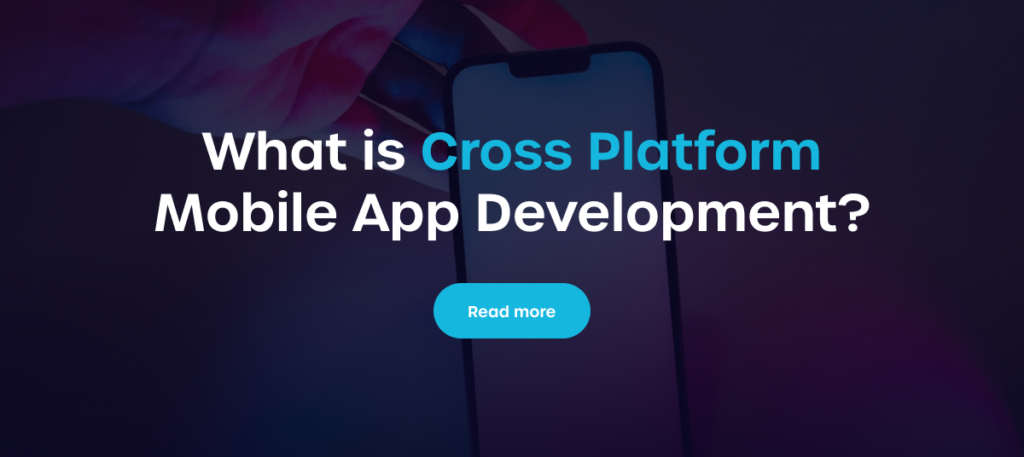Cross-Platform Development can be an exceptional solution to boost your business growth. It doesn’t matter if you are a small startup or a huge company, this technology can save your time and keep a lot of dollar bills in your pocket. In this article we will give you every bit of information you need to start your journey with Multiplatform Development. From the definition, through the benefits all the way to comparison of the best frameworks.
What You Need To Know About Cross-Platform Development
Cross-Platform Development means creating an application with one codebase, that works across multiple operating systems like iOS, Android and even Windows. This approach allows companies to hire a single team to develop and maintain the app, which results in ton of benefits, especially in terms of costs, time and bigger audience.
Cross-Platform Development – Web and Mobile Apps
It is crucial to mention that Cross-Platform Development is not only reffering to mobile operating systems. Some of the multiplatform frameworks allow developers to work on mobile and web apps simultaneously. Most of them also use programming languages that are associated with web applications, which allows developers to onboard into the project quickly and smoothly.
However, if you decide to create your app on web, iOS and Android on one codebase, you will have to overcome couple of obstacles. Not every single function that works on mobile systems will function in the web application and vice versa. That’s why it is essential to hire a competent team, who will solve those issues efficiently and quickly.
Multiplatform against Native Development
When comparing cross-platform mobile app development to native development, the key difference lies in flexibility and resource efficiency. Single codebase results in reduced development time and lower costs, making it an attractive option for businesses that need to launch their apps on multiple platforms simultaneously.
On the other hand, native development, while more time-consuming and expensive, allows for apps to be fully optimized for each platform, offering a little bit better performance, easier access to platform-specific features, and a more refined user experience. Cross-platform solutions may face limitations in utilizing certain native features, which can impact app functionality or performance.

Real World Case Studies
As we mentioned earlier, even the biggest companies in the world can benefit from Cross-Platform Development. Some of the most popular apps globally have incorporated React Native in their development in various ways.
For example, Instagram uses React Native for several parts of its app, while Walmart and Discord share over 90% of their code between platforms, making React Native an essential part of their development strategies. Here are some other examples of applications using cross-platform development:
- Facebook - creator of React Native uses the framework for both its main app and the Facebook Ads Manager.
- Pinterest - uses multiplatform development for its iOS and Android apps, allowing the team to launch updates on both platforms with shared code.
- Tesla - Tesla’s app, which allows users to control their vehicles and manage settings, is developed using React Native to work efficiently across iOS and Android.


Key Benefits of Choosing Cross-Platform Development
We already established that the biggest benefits of choosing multiplatform mobile app development are minimizing expenses and effort. But what exactly does it mean? In this paragraph you'll get to know how much money and time you can save, why is cross-platform development so efficient and how you can reach wider audience with this technology.
Cost-Effectiveness of Cross-Platform Development
First thing that we can save money on is obviously one codebase. Instead of hiring multiple teams you can delegate one to create a fully working app, without having to add a lot of native code. This guarantees 30-50% less costs just on development alone. The exact amount of the money saved depends on size and type of the project, because some of the products will require a lot of native code, while others almost none.
But that's not where cutting down on expenses ends. After your app is deployed and ready to use, you will for sure want to update it to keep making it better. That's also a huge advantage of Cross-Platform Development, because, similarly to the previous example, there is only one codebase that needs to be handled.

Faster Time to Market with Cross-Platform Solutions
With cross-platform solutions, businesses can significantly reduce the time it takes to bring their apps to market. In addition to lowering costs, developing a single codebase accelerates the entire app development process. This approach streamlines development, testing, and deployment, allowing teams to release the product faster.
Furthermore, it enables companies to respond faster to market demands and user feedback, ensuring timely updates and new features across all platforms. By leveraging cross-platform development, businesses not only shorten their development cycles but also gain a competitive edge by being able to deliver products to users more quickly.
Top Cross-Platform Development Frameworks You Should Consider
Now that you know what benefits Multiplatform App Development brings, you can check out what are the best frameworks that you could use when creating your apps. There is couple of good options, but in our opinion one framework stands alone as a leader.

React Native
React Native is by far the most popular framework for cross-platform development that you can use in your app. There are tens of thousands applications created in this technology that you can download right now from Google Play or App Store.
There are few factors that make this framework superior to others:
- Native experience: React Native's components make sure that user experiences native feeling across all platforms.
- Huge community: The framework is using JavaScript, one of the most widely addopted programming languages in the world.
- Easy integration with existing apps: If you already have native app, that's not a problem! Integrating it with React Native for easier maintenance shouldn't be an issue.
Other Options for Cross-Platform Development
Even though React Native appears to be the best all-around cross-platform framework, other options could also be a good choice if you are willing to create specific project. Here is a list of the frameworks that you could consider if React Native doesn't fit your app:
- Flutter: Beautiful UI's and stellar performance, but problematic integration with native components and unpopular programming language - Dart.
- Xamarin: Framework introduced by Microsoft. If you need your app integrated with Windows, you might consider this choice.
- Ionic: Focused on web technologies like HTML, CSS and JavaScript. This makes it easier for web developers to transition into mobile app development.
FAQ
What is Cross-Platform Development?
Cross-Platform App Development focuses on creating application on multiple platforms, like Android, iOS or web, using a single codebase.
What are The Biggest Benefits of Multiplatform Development?
Three biggest benefits of Cross-Platform Development are:
- Reducing expenses
- Saving time
- Reaching wider audience
What is The Best Framework for Cross-Platform Development?
Considering popularity and usage among the biggest companies in the world, best framework for cross-platform development has to be React Native, which allows users to have native experience without compromising performance.






